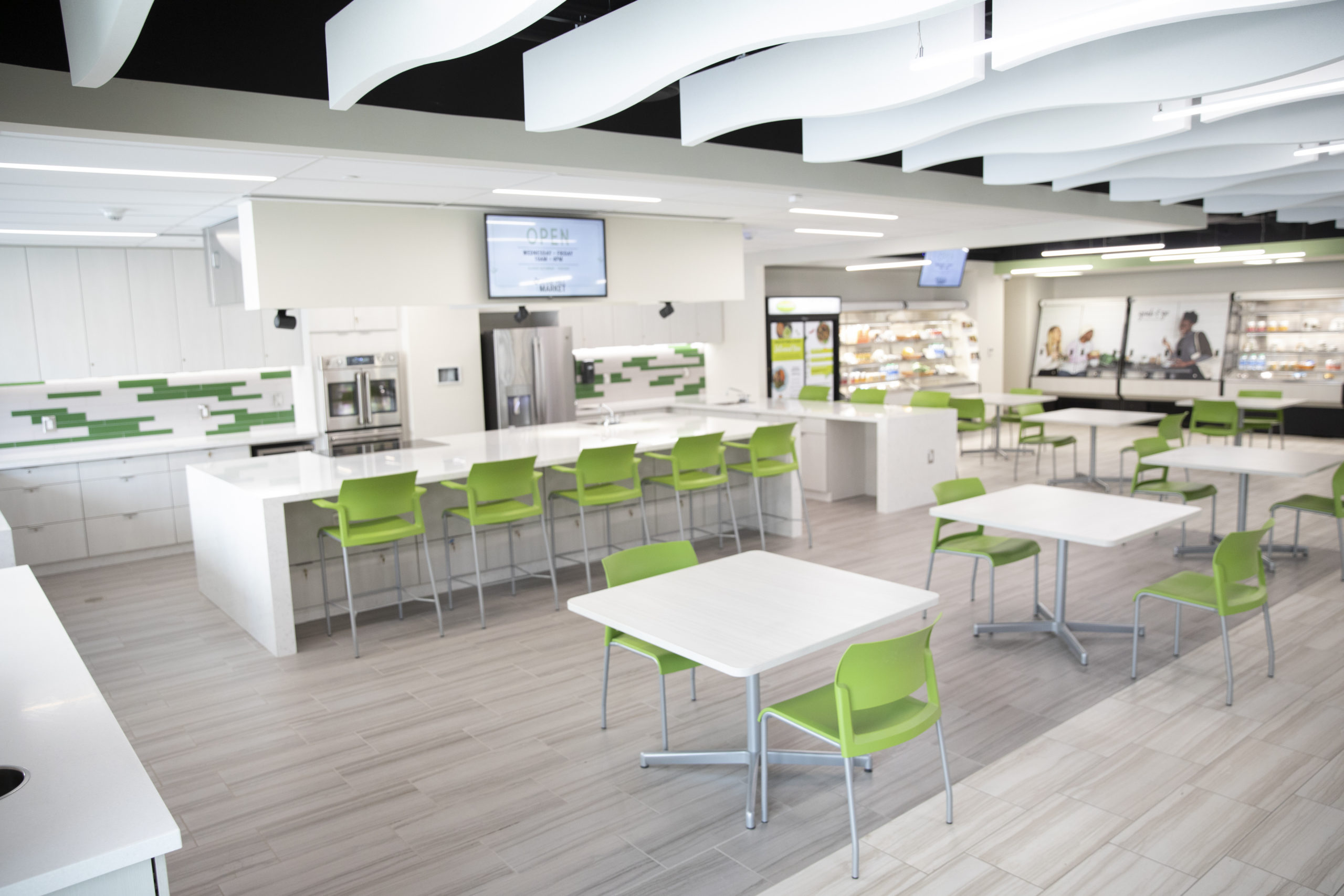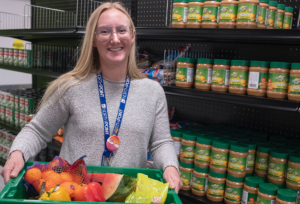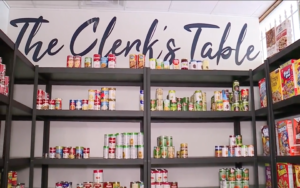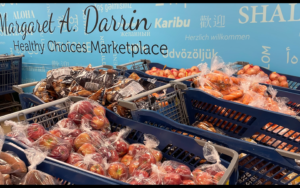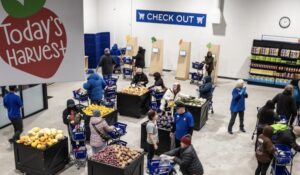Some of the nation’s largest food banks are setting new standards for the food pantries of the future.
Food banks among the top 20 on Food Bank News’ list of the largest 100 have recently designed and introduced food distribution outlets that differ sharply from traditional pantries. Like other emerging distribution models, including Foodlink’s mobile health units, Northern Illinois Food Bank’s online ordering system, the virtual food bank of Feeding Children Everywhere and Northwest Harvest’s community market, the new outposts reflect increased recognition of the growing need for more equitable access to healthy food.
While food pantries have long been the main driver of food banks’ distribution efforts, food banks are generally hands-off when it comes to how those pantries are operated. Pantries set their own hours, choose the quantity and type of food they will serve, and determine whether it will be distributed grocery-store style or as a prepackaged bag.
In the emerging food pantry models, food banks are having more of a direct say in the look, feel and operations of the outlets. Often, but not always, they are working in partnership with other community groups, including health care providers. The following is a look at emerging food-pantry distribution strategies of three large food banks: Atlanta Community Food Bank, the Greater Boston Food Bank and the Houston Food Bank.
ATLANTA COMMUNITY FOOD BANK
Atlanta Community Food Bank recently unveiled two initiatives aimed at expanding access to healthy food. The food bank is among the nation’s top ten, with $164 million in 2019 revenue, according to Food Bank News’ listing of the top 100 food banks.
The first is an outlet at a large safety net hospital in Atlanta, which has the look and feel of an upscale market, along with areas to dine in and take cooking or nutrition classes. Patients with food prescriptions can pick up a 20-pound box of food provided by the food bank twice a month, while the general public can purchase affordable healthy snack options.
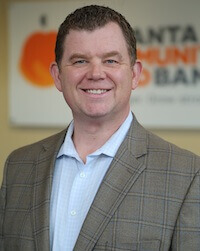
The Jesse Hill Market (seen above), which replaces a former McDonald’s site on the hospital campus, is the result of a partnership and joint fundraising effort between the food bank, Open Hand, an Atlanta-based provider of medically tailored meals, and Grady Health System, which houses the site.
The other effort is the new high-capacity Community Food Center, strategically located to meet the unmet needs of communities beyond the bounds of the food bank’s existing pantry network. The 14,000-square-foot center — directly owned and operated by the food bank — is expected to distribute 650,000 pounds of healthy food to local families in its first year, while also serving as a hub to pantries in nearby areas.
While currently operating as a drive-through, the center will be a client choice facility post-Covid, with shopping aisles, merchandised healthy products and reach-in coolers. The food bank plans to open four to six additional similar food centers over the next few years.
Both locations, which offer help in accessing benefits such as SNAP and WIC, are Exhibit A in Atlanta Community Food Bank’s efforts to broaden its array of food access points. “We think of food distribution as a pipe, and we need to keep making the pipe bigger,” said Kyle Waide, President and CEO.
While the food bank plans to continue nurturing its existing network of traditional food pantries, which numbers about 600, it also knows that “the majority of growth will come from new places,” Waide said, including mobile pantries, schools, health care systems, and other community organizations. “We’re going to see the traditional network grow, but other parts will grow faster,” Waide said. “We’ve got to get more pipe.”
GREATER BOSTON FOOD BANK
Just weeks before the Covid-19 crisis hit, the Greater Boston Food Bank, the largest in Massachusetts with $107 million in 2019 revenue, opened a “best-in-class” food pantry in a city identified as a priority for tackling food insecurity.
Three years in the making, the Mystic Community Market in Medford, Mass., reflects the food bank’s ideals about food distribution, including letting clients choose their own foods (in non-pandemic times) from displays of healthy produce, while enjoying a quick shopping experience and convenient hours.
Greater Boston Food Bank originally intended to own and operate the market. But that plan shifted when the food bank’s advisory council of partner pantries voiced concern, noting that a community organization would have stronger ties to the areas in need. The result was a partnership with a local YMCA — as well as a new strategic direction for the food bank.

“We totally will continue working with community groups” in opening new pantries, said Carol Tienken, Chief Operating Officer. “We believe the sustainability is much higher.”
The food bank laid the groundwork for its new model by getting the city government to create a food security task force and pledging to create a hunger-free community. Under its partnership model, the food bank helps to fund the market, including some professional staff, for three years on a sliding scale, with more money being invested early on and less as the community group takes on greater ownership.
As a result of the pandemic and as word went viral on Facebook about the high quality of the food being distributed, the market has served three times as much as its annual expected outlay of 500,000 pounds of food in only nine months. It has also reduced lines by automating check-ins, and is looking to add convenient online ordering.
With the Mystic Community Market having exceeded all of the food bank’s expectations, Greater Boston Food Bank is seeking to work with the YMCA and other groups to establish markets in other communities. “It’s like a new friend that’s always been there but we never had a relationship with,” Tienken said of the food bank’s growing ties to the YMCA. “I think this model is going to be very strong for us.”
HOUSTON FOOD BANK
Houston Food Bank, the nation’s third largest food bank with $209 million in 2019 revenue, recently opened a second Food Farmacy, in partnership with a large, Houston-based healthcare organization, Harris Health System.
The two farmacies, located on opposite sides of the city, serve patients with elevated levels of diabetes risk, providing them with 30 pounds of fruits and vegetables, as well as whole grains and lean protein every two weeks. A third Food Farmacy is expected to open in 2021 in one of Harris Health’s hospitals.

Under a Houston Food Bank program called Food Rx, Harris Health is tracking patients’ blood-sugar levels over time to assess the impact of the food distributions on patient outcomes, an important step in justifying public expenditures on food as medicine. “One of the goals of collecting the data is to present a business case to health plans and government entities to show impact,” said Esther Liew, Food for Change, Health Partnerships Manager.
The Food Rx program builds upon a related effort called FIRST Link. Under FIRST Link, Houston Food Bank staff trains health care providers to conduct food insecurity screenings. Qualified patients get referred to food bank staff to get help with federal aid, as well as referrals to pantries that have been specifically chosen for their ability to provide fresh and healthy food in a grocery-store-like environment. So far, 18 healthcare partners are running either Food Rx, FIRST Link or a combination of both.
Harris Health is the only partner to house food-insecurity screenings and food distributions in the same location. “It makes it easier for the patient to access,” Liew noted, creating more touchpoints between patients and providers, and providing a better window into impact. “It makes it so much more credible.”
CAPTION ABOVE: Atlanta Community Food Bank’s Jesse Hill Market supports food prescriptions, healthy snacks and nutrition and cooking education.
Like what you’re reading?
Support Food Bank News
